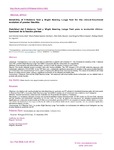Mostrar o rexistro simple do ítem
Fiabilidad del Y-Balance Test y Wight Bearing Lunge Test para la evolución clínico-funcional de la fascitis plantar
| dc.contributor.author | García Vidal, José Antonio | |
| dc.contributor.author | Sánchez Martínez, María Piedad | |
| dc.contributor.author | Baño Alcaraz, Aitor | |
| dc.contributor.author | Piñero Palazón, José Gregorio | |
| dc.contributor.author | Martín San Agustín, Rodrigo | |
| dc.date.accessioned | 2019-02-27T09:37:58Z | |
| dc.date.available | 2019-02-27T09:37:58Z | |
| dc.date.issued | 2018 | |
| dc.identifier.citation | European Journal of Podiatry, 2018, 4 (2): 45-52 ISSN: 2445-1835 | es_ES |
| dc.identifier.issn | 2445-1835 | |
| dc.identifier.uri | http://hdl.handle.net/2183/21988 | |
| dc.description.abstract | [Resumen] Objetivos: Los objetivos de nuestro estudio han sido determinar en pacientes con FP unilateral la fiabilidad intraobservador del instrumento Y- Balance Test (YBT) y la prueba Wight Bearing Lunge Test (WBLT) medida con el inclinómetro de un telefono movil inteligente. Métodos: Estudio transversal y observacional, realizado con 16 pacientes (9 mujeres y 7 hombres). Resultados: Los resultados obtenidos revelan una excelente fiabilidad relativa intraobservador. El YBT mostró un CCI de 0’946; mientras que las medidas con inclinómetro obtuvieron un CCI de 0’992. En el YBT se apreció una asociación de variables estadísticamente significativa en la dirección posteromedial (p=0’004) y en el resultado general (p=0’017), al comparar el miembro inferior afecto y el sano. Los valores de flexión dorsal en carga con flexión de rodilla se encuentran dentro de los valores normales, sin una asimetría significativa del miembro afecto y el sano. Conclusiones: El Y-Balance Test y la prueba Wight Bearing Lunge Test medida con inclinómetro de teléfono movil inteligente son dos pruebas fiables en pacientes con FP. | es_ES |
| dc.description.abstract | [Abstract] Objectives: The objectives of our study have been to determine in patients with unilateral PF; The intraobserver reliability of the Y-Balance Test (YBT) and the Wight Bearing Lunge Test (WBLT) measured with the inclinometer of a smartphone. Methods: Cross-sectional and observational study, carried out with 16 patients (9 women and 7 men). Results: The results obtained reveal a excelent intra-rater relative reliability. The YBT showed a CCI of 0.946; while the measures with inclinometer obtained a CCI of 0'992. In the YBT there was a statistically significant association of variables in the posteromedial direction (p= 0’004) and in the overall result (p= 0’017), when comparing the affected lower limb and the healthy. The values of dorsiflexion with knee flexion are within normal values, without a significant asymmetry of the affected and healthy limb. Conclusions: Y-Balance Test and the Wight Bearing Lunge Test measured with smart mobile phone inclinometer are two reliable tests in patients with plantar fasciitis | es_ES |
| dc.language.iso | spa | es_ES |
| dc.publisher | Universidade da Coruña | es_ES |
| dc.relation.uri | http://dx.doi.org/10.17979/ejpod.2018.4.2.3812 | es_ES |
| dc.subject | Fascitis plantar | es_ES |
| dc.subject | Pie | es_ES |
| dc.subject | Rango de movimiento | es_ES |
| dc.subject | Evaluación física | es_ES |
| dc.subject | Plantar fasciitis | es_ES |
| dc.subject | Foot | es_ES |
| dc.subject | Range of motion | es_ES |
| dc.subject | Physical examination | es_ES |
| dc.title | Fiabilidad del Y-Balance Test y Wight Bearing Lunge Test para la evolución clínico-funcional de la fascitis plantar | es_ES |
| dc.title.alternative | Reliability of Y-Balance Test y Wight Bearing Lunge Test for the clinical-functional evolution of plantar fasciitis | es_ES |
| dc.type | journal article | es_ES |
| dc.rights.accessRights | open access | es_ES |
| UDC.journalTitle | EJPOD: European Journal of Podiatry = Revista europea de podología | |
| UDC.volume | 4 | es_ES |
| UDC.issue | 2 | es_ES |
| UDC.startPage | 45 | es_ES |
| UDC.endPage | 52 | es_ES |






